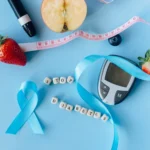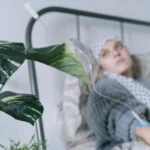Despite the fact that early-stage breast cancer typically exhibits no symptoms, prompt discovery can transform a breast cancer narrative into one of survival.
The most frequent symptom to show is a breast lump. However, the wide range of symptoms for 1 in 6 breast cancer patients does not involve a lump. [Ref]
Diagnosing breast cancer in the early stages can have significantly better outcomes compared to a delayed diagnosis.
To diagnose breast cancer in the early stages, it is important to know the signs and symptoms of early breast cancer.
1. Nipple retraction or inversion:
Cell alterations behind the nipple can be brought on by breast cancer. The nipple may flip and reverse into the breast as a result of these changes, or it may alter in size or appearance.
People should see a doctor if they notice any new nipple alterations since the shape of the nipples can frequently change during ovulation or other phases of the menstrual cycle.
You may also like to read:
2. Pain in The Nipple or Breast:
Breast pain, tenderness, and discomfort can result from changes in skin cells brought on by breast cancer. There is no discomfort if a lump is present.
Despite the fact that breast cancer is frequently painless, it is crucial to pay attention to any signs or symptoms that can be related to the disease.
Some people can describe the discomfort as being sensitive and stinging.
3. Rash on The Breast:
An infection or other common condition is frequently indicated by a painful spot or rash on your breast.
In other instances, it’s a sign of a prevalent, curable skin illness. Rarely, a rash and pain may be symptoms of inflammatory breast cancer. An uncommon and severe kind of breast cancer is inflammatory breast cancer (IBC).
IBC makes up 1 to 5% of all breast cancer cases in the US. This illness is really dangerous.
Nevertheless, a consistent rash on the skin is nothing that needs to be ignored. This can probably be an early manifestation of breast cancer.
So, if you experience a rash on your breast that is not going away with topical medication, consult your doctor.
You may also like to read:
4. Alterations in the size of the Breast:
It’s common for people to have breasts that are different sizes from one another. On the other hand, if one breast grows in size mysteriously, it could be an indication of breast cancer.
A rapid increase in breast size may be a sign of inflammatory breast cancer, according to the National Cancer Institute [Ref].
Even though changes in breast size can be a sign of any form of breast cancer, this is an uncommon and severe kind of breast cancer.
People might think about calling a doctor if they discover that one or both of their breasts have grown in size.
5. Swelling in the breast:
A region of the breast or the whole breast may enlarge as a result of breast cancer. After this swelling, there might not be a clear lump, but the breast might be bigger than the other breast.
Even while it is common for individuals to have somewhat different-sized breasts all the time, this swelling would appear somewhat different from their typical breast size.
Breast swelling might feel like a weight in your breast and cause pain or discomfort in the area surrounding your breast and possibly up into your armpit.
Women over the age of 45 are advised to have frequent mammograms since breast swelling can occasionally be an early indication of breast cancer.
You may also like to read:
6. A persistent lump in the breast after your periods:
The most typical indicator of breast cancer is a lump in the breast. Finding one might be frightening, but the majority of breast lumps turn out to be benign.
A large number of breast cancer lumps are hard and painless, but there are some exceptions. It’s probable that a malignant breast lump will feel hard or stiff.
A breast cancer lump also has uneven borders, can’t be moved with your fingertips beneath the skin, is growing, and is positioned in the upper outer quadrant of your breast.
However, these lumps can be seen during your regular menstrual cycle but if the lump does not go away even after your menstrual cycle, that is when you need to worry.
7. Discharge from the nipple:
Any fluid or other liquid that leaks from your nipple is known as a nipple discharge. The fluid may need to be squeezed out of the nipple or it may just leak out naturally.
Even if you are not pregnant or nursing, nipple discharge is frequent during the reproductive years. Most discharges are not severe. Still, it’s worth discussing with a doctor because it may be an indication of breast cancer.
Nipple discharge can be brought on by breast cancer, particularly ductal carcinoma in situ (DCIS), an early stage of the disease that begins in the milk ducts.
Paget’s disease of the breast, a rare kind of breast cancer that affects the nipple, is another instance of it.
The discharge will likely only flow from one breast if you actually have breast cancer. You can also have a lump in that breast.
You may also like to read:
8. Irritation of skin around the breast:
In conjunction with swelling of the breast, there can be a consistent itch and irritation that can be similar to an insect bite.
With dilated pores in the breast skin, the breast often turns red, puffy, and warm.
This irritation can be serious when it becomes obvious in conjunction with other symptoms of breast cancer.
9. Changes in color, texture, and dimpling:
Skin pigmentation is a symptom of the existence of malignant cells in the breast. Another sign of breast cancer might be if your breasts appear bruised or are not exactly the right color.
Cancer may alter your skin in several ways, not only in terms of color. A warning indicator is a change in the skin’s texture around the nipple and on the breast.
These changes may also be accompanied by itchiness. A professional examination is always your best choice because changes in skin tone or texture might potentially be signs of a benign skin disorder.
Dimpling is the first sign of breast cancer that has to be examined. It refers to the orange-skin-like rough, “pitted” appearance that your breast skin occasionally takes on.
This phenomenon results from an accumulation of lymph fluid and may be one of the early warning symptoms of inflammatory breast cancer.
You may also like to read:
In conclusion:
Signs and symptoms of early breast cancer can be subtle and may be misdiagnosed as infection or mastitis.
These symptoms, if persist despite topical or oral antibiotics and anti-inflammatory medicines, must be evaluated to avoid delay in the diagnosis of early breast cancer.
[web_stories title=”false” excerpt=”false” author=”false” date=”false” archive_link=”true” archive_link_label=”https://dibesity.com/web-stories/symptoms-of-breast-cancer/” circle_size=”150″ sharp_corners=”false” image_alignment=”left” number_of_columns=”1″ number_of_stories=”2″ order=”DESC” orderby=”post_title” view=”circles” /]



